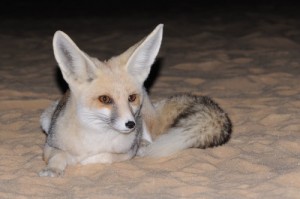Rueppell’s Fox
Bongsong · 9 months ago
Named after the German naturist Eduard Rueppell (who also had many other species take his name), Rueppell’s Fox can be found across North Africa and the Middle East. Another fox that inhabits desert areas, Rueppell’s Fox has very large ears that help to keep it cool in very high temperatures. With a white tuft of fur at the end of it’s tail and a red sandy tinge to it’s fur, Rueppell’s Foxes have hairy pads on the bottom of their feet. This helps them to walk on desert sand that reaches excruciating temperatures. The scent glands of Rueppell’s Fox are very important to it’s way of life and interaction with other foxes and predators. Territories are marked, greetings are made and predators are sprayed all with their scent glands. The glands are important to the female when raising young as she will mark the den with her scent. Very nocturnal, Rueppell’s foxes are quick to vacate their dens are either find or create a new one if they are disturbed. A typical Rueppell’s Fox litter will contain 2-3 cubs and after mating season, Rueppell’s Foxes break from their monogamous way of life and travel in fairly large groups. The fox pups will branch out on their own after around 4 months and by 12 months will be ready to mate, which usually occurs in winter. As with so many foxes, Rueppell’s Foxes are opportunistic and adaptable eating mainly insects, but also a wide variety of food from eggs, small mammals and vegetation. They normally hunt alone will also hunt for chickens and other livestock if presented with the chance. Their main predators are eagle owls and steppe eagles and a wild Rueppell’s Fox can expect to live for around 7 years.
